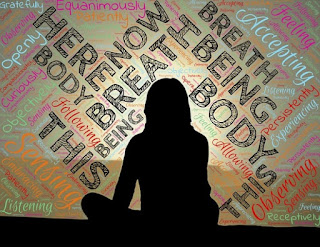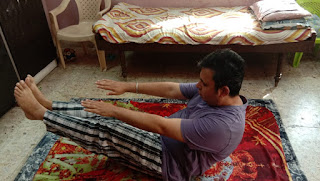Breathing Exercise - How to do Rhythmic Breathing and its Benefits
 |
| Rhythmic Breathing and its Benefits |
Rhythmic Breathing is neither difficult nor dangerous. Everyone can practice it. Rhythmic breathing has two variations:
- In first variation inhalation takes exactly the same time as exhalation.
- In second variation, inhalation and exhalation take same amount of time. But there is a pause between both which is equal to half of the time of inhale and exhale.
For this type of breathing it is important to concentrate mentally on the rhythm until we become used to it.
Yogis time their breathing rhythm taking into account the rate of their heartbeat which may differ from person to person. The important point is to adjust the breathing to one’s own rhythm.
This should only be done after a minute of relaxation. To count the heartbeats and establish a suitable breathing rhythm, the pulse should be taken while counting from 1 to 6. This should be repeated until the rhythm is clear in one’s mind. By practising this type of breathing, one can achieve equilibrium of the nervous system.
Rhythmic Breathing Technique
First Variation
- Sit cross legged holding the chest, neck and head in a straight vertical line with hands on knees (those who find it difficult to sit cross-legged may perform this exercise lying on their back).
- Inhale as in complete yogic breathing, mentally counting 6 heartbeats, and then slowly exhale through the nostrils, again counting to 6. Repeat the exercise several times.
Second Variation
- In this variation posture remains the same.
- Inhale deeply and count from 1 to 6.
- Hold the breath and count from 1 to 3.
- Now exhale slowly counting from 1 to 6 again.
- Stop breathing to a count of 3.
- Repeat the process again several times as per capacity and comfort.
It is imperative to have proper guidance as to the number and duration of exercise.
The beginner should concentrate particularly on acquiring a rhythmic breathing pattern without straining to prolong the duration of inhalation and exhalation. Only after long practice we will able to count up to 16 beats instead of 6. By practising this type of breathing, one is eventually able to communicate soothing rhythmic vibrations to the whole of the body.
Once rhythmic breathing has become automatic, we ought to feel that each inhalation is filling us with calm, and each exhalation transmitting it to the tiniest fibres of the body like a current passing through our cells. We shall find that the whole body becomes rhythmical and harmonious. Hence due to rhythmic breathing all the molecules in the body tend to move in the same direction.
Advantages of Rhythmic Breathing
- A totally exhausted body revives and the most tired frayed nerves become calm.
- We experience genuine rest, better even than that of sleep as it is acquired consciously.
- A relaxed expression appears on the face, wrinkles soften, as do the features.
- We sleep better and a new life flows through the body.
- Rhythmic breathing brings health to body and mind.
- It allows more oxygen to the body, relieves the ageing of muscles, helps to re-establish the equilibrium of the nervous and neuro-vegetal systems.
- It also eliminates anxiety by acting on the sympathetic nerve and the thalamus (interior region of the brain).



fe2
ReplyDelete